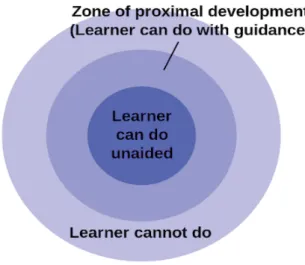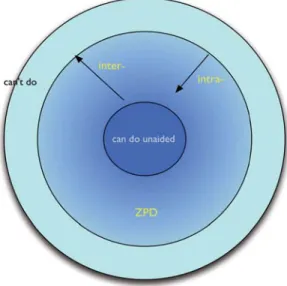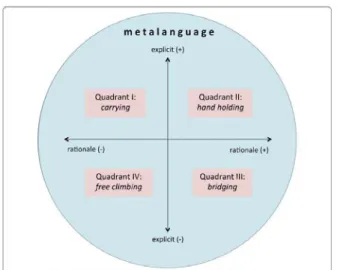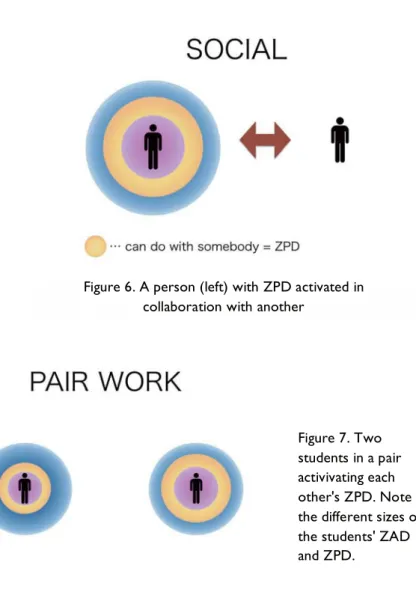Richard S. LAVIN and Yukari NAKANO
Visualizing the Concept of the ZPD
in Language Education
Abstract
This paper concerns the Vygotskian concept of the Zone of Proximal Development (ZPD) and its applications in second language teaching. We start with an introduction to the concept and its place within the Vygotskian framework. We look at the implications of the spatial metaphor implied by the term and, in light of that discussion, suggest some issues with the defi nition and propose a new one. We then off er an overview of understandings of the ZPD concept in the literature. This overview includes some expansions of the ZPD concept in terms of the participants and the notion of reciprocity. Since as mentioned the ZPD implies a spatial metaphor, we conclude with a survey of existing graphical representations of the notion and propose our own.
1. Introduction
The Zone of Proximal Development (ZPD) is generally defined as “the distance between the actual development level as determined by independent problem solving and the level of potential development as determined through problem solving under adult guidance” (Vygotsky, 1978, p. 86). We will return to this defi nition later in the paper. The ZPD is commonly explained in terms of a parent or teacher providing assistance to a child. The general idea is that there are things that a child cannot do alone but can do with assistance, but that traditional tests such as IQ tests cannot measure the latter, and hence fail to see children’s potential. Thus, the notion was at fi rst put forward as a diagnostic method, refl ecting Vygotsky’s dissatisfaction with current psychometric tests. However, after
Vygotsky’s death, others explored the educational potential of the concept. (Nowadays, the term dynamic assessment (e.g. Lidz, 1995) is commonly used to represent testing in a ZPD framework.)
The notion of the ZPD is closely related to that of internalization. Vygotsky, following Pierre Janet (Vygotsky & Kozulin, 2012, p. xli), believed that every higher psychological function was once a social relation. In Vygotsky’s words, “Any function in the child’s cultural development appears twice, or on two planes: first it appears on the social plane, and then on the psychological plane; fi rst it appears between people as an interpsychological category, and then within the child as an intrapsychological category” (Vygotsky, 1981, p. 163). Internalization is the process whereby the external function becomes an internal function. However, not every function can be internalized easily; the individual needs to be equipped or ready to internalize it. In other words, that function or ability needs to be within the individual’s ZPD, and appropriate assistance needs to be available.
Internalization was defined by Vygotsky (1978) as “internal reconstruction of an external operation” (p. 56) and can appear to be a mysterious process whereby something that was external magically becomes internal. Zaretskii (2009), however, draws an analogy with the development of a plant, which involves several stages, such as a stalk breaking out of a seed and leaves appearing. Developing Zaretskii’s analogy, we might say that, in learning, micro-changes are happening all the time, and normally we would not make a big deal of each tiny change that increases one’s knowledge or understanding in a minuscule way. However, in a plant we would tend to see a transition from the non-existence of a stalk to the non-existence of a stalk as a signifi cant qualitative change. For Zaretskii, the pedagogical significance of the ZPD is that it off ers a conceptual tool for identifying and examining transitions in human learning and development.
Another related concept is imitation. The term is somewhat problematic in the field of language learning, since it has come to be
associated with the discredited audiolingual approach, in which context it is often caricatured as rather mindless rote repetition or mimicry, often without understanding. Even in stereotypical audiolingualism, this caricature is rather unfair; after all, in order to successfully carry out even a simple pattern drill, the ability to recognize a pattern and the part to be substituted is essential. The caricature also tends to ignore the tradition of work in imitation represented by Baldwin (1894) in which “persistent imitation” is defined as a kind of imitative performance, supported by some kind of understanding, where aspects of the model are appropriated by the imitator and the thing imitated in some sense comes to belong to the imitator. This kind of imitation is also called “expanded” and “deferred” (Snow, 1981).
Vygotsky used the metaphor of a fruit farmer to illustrate the necessity of the ZPD concept, a fact highlighted by Zaretskii (2009). Viewing his crop of fruit, the farmer would take note not only of fruit that had already ripened and needed to be harvested right away, but also the fruit that would need to be harvested very soon as well as the fruit that would still take some time to mature. Ignoring all but the already ripened fruit would represent a kind of negligence on the part of the farmer. For Vygotsky, judging the development of a schoolchild based only on conventional tests represented a similar kind of negligence.
2. Defi ning the ZPD
Let us look more closely at defi nitions of the ZPD. As mentioned above, it is frequently defined thus: “the distance between the actual development level as determined by independent problem solving and the level of potential development as determined through problem solving under adult guidance” (Vygotsky, 1978, p. 86).
This is often off ered as an unproblematic defi nition, but a kind of metaphoric dissonance is immediately apparent between the terms “zone” and “distance”. While distance is a one-dimensional concept, zone is at
least a two-dimensional one. In educational terms, “distance” suggests to us a narrow, assessment-oriented concept that goes against the spirit of most work carried out within a Vygotskian framework. Therefore, as a fi rst step towards refi ning the defi nition of ZPD, we suggest removing any mention of one-dimensional concepts, and replacing “distance” with “area”. Since clearly we are using a metaphor that is spatial in nature, let us carry out a more thoroughgoing rewrite. The ZPD can be defi ned as:
the area between the space representing internalized problem-solving skills (the zone of actual development, ZAD) and the space representing problem-solving skills beyond current capabilities (the zone of potential development, ZPoD), i.e. the area where problems can be solved with guidance.
This rewrite exposes another ambiguity in the traditional defi nition, involving whether “between” should be interpreted inclusively or exclusively. Let us assume that there are three categories of actions or tasks for a child or learner:
(a) those that are internalized suffi ciently for independent performance; (b) those that the child or learner is able to do with guidance;
(c) those that are beyond current capabilities, even when assistance is off ered.
The standard defi nition appears to refer to the area between (a) and (b). If the conventional, exclusive defi nition of “between” is adopted, then it refers to an area that is neither internalized, nor amenable to guidance, nor something completely beyond current capabilities, i.e. a null area. If, on the other hand, we use an inclusive defi nition of “between”, the ZPD includes everything that has already been internalized in addition to those abilities that might be learned with guidance, and thus is insufficiently discriminatory.
3. Expanding the ZPD
As mentioned earlier, Vygotsky generally spoke of the ZPD in terms of an adult providing assistance to a child. Later work has tended to allow for a ZPD constructed between peers. One example from teacher education is Nyikos and Hashimoto (1997). More recent works in this strand of research are Warford (2011) and Fani and Ghaemi (2011).
More commonly, the notion is used to conceptualize pair and group work in schools. Donato (1994) was one of the fi rst papers to demonstrate that students working in groups in a foreign language classroom could scaffold each other in ways quite similar to the ways in which teachers scaff old students. (Scaff olding is a term introduced by Vygotsky and Luria to explain how parents “teach” children aspects of culture (van der Veer & Valsiner, 1991).) Similarly, De Guerrero and Villamil (2000) demonstrate how pairs of students activate each other’s ZPD in peer revision of writing. This leads to the notion of multiple ZPDs in the classroom, one for each student created by one or more other students. Ohta (1995), working in a Japanese as a Second Language (JSL) context, found that teacher-led interaction was generally impoverished, with students reluctant to say very much for fear of making mistakes. She found that, when communicating together, students create supports for each other, with students “learning and progressing in the zone of proximal development”. Ohta emphasizes that it is not just weaker students benefiting from stronger students but that benefi ts are mutual as “learner strengths are collaboratively joined”. Takahashi (1998), working in a children’s JSL context, notes how peer collaboration, even for beginners in a generally teacher-fronted framework, plays an important role in helping the formation of a ZPD.
The above works appear to tacitly hold to the view that, even where two peers are helping each other, each has his or her own ZPD which is active when he or she is being assisted by the other. Poehner (2008) draws attention to the reciprocity inherent in a ZPD: just as the assister needs to consider how best to help the assisted, so does the assisted have to
consider how to get the help that he or she needs.
In the above works, the nature of the ZPD, or ZPDs, being constructed is rather unclear. A more holistic picture is presented by Guk and Kellogg (2007). They examine closely the kinds of utterances that occur in teacher-fronted talk and in group work, concluding that an interactive classroom leads to the formation of a single, whole-class ZPD, in which teacher-fronted talk and group work play different roles. Teacher-fronted talk is generally located at the outer boundary of the ZPD and is focused on expanding the ZPD outwards. By contrast, student collaboration dialogue tends to be located at the inner boundary of the ZPD and serves to push that boundary inwards by bringing about internalization. Poehner (2009) notes that, in order to carry out more effective research within a Vygotskian framework, so thoroughly social in orientation, it is necessary to recognize the group “as a psychological entity in itself” (p. 473) and move beyond an exclusive focus on group as context for each individual’s actions and achievements to the idea of “group-as-collaboration” or further to the “group-as-collective” model. 4. Diagramming the ZPD
Since the ZPD appeals to metaphor for its comprehension, we feel that graphic aids can play an important role in helping researchers working within a ZPD framework to clarify their thinking. We conclude this paper with a discussion of some interesting graphical representations of the ZPD in the literature, and add some tentative contributions of our own.
A typical representation of the ZPD is shown in Fig. 1. If we want to show the dynamic nature of the ZPD, we could use something like Fig. 2. These show the tendency for abilities that are nurtured to move from the outer part of the ZPD towards the inner part, and then eventually to be internalized.
Zaretskii (2009), working with children with learning diffi culties, suggests that a child’s learning is happening simultaneously on three
planes. Firstly, the child is working on the specifi c ability being “taught” in the moment. Secondly, while learning that activity, the child is also making progress towards developing general strategies for overcoming learning diffi culties. Finally, the child is also making general cognitive and personality-related changes. Zaretskii’s fi gures represent all three planes. (We reproduce one of them in Fig. 3In general, we do not see the need for this style in second language research, though it could be useful when mapping mastery of specific grammatical features against conceptual understanding of a larger grammatical concept, for example.
An interesting approach is that taken by Devrim (2014), who refers to a topology of written feedback arranged on two clines, explicitness and rationale. These mean, respectively, the extent to which the learner is given “the correct answer” and whether any supporting rationale for that correct answer is offered. Devrim uses the terms carrying, handholding, bridging, and free climbing to mean, respectively, explicit feedback
without rationale, explicit feedback with rationale, less explicit feedback with rationale, and implicit feedback without rationale (Fig. 4).
Devrim, while working within the Sydney School (systemic functional linguistics) framework, links his work explicitly to the notions of scaff olding and the ZPD.
Offering a more granular representation of the ZAD as well
Figure 2. A ZPD schematic incorporating the notion of movement within the ZPD
as some internal structure to the ZPD, Obukhova and Korepanova (2009) nevertheless manage to use a sparse-looking, two-dimensional representation (Fig. 5).
To conclude, as our modest contribution to the literature, we off er here our graphical representations of some aspects of the ZPD. The originals are in full color and can be viewed online and used by other researchers.1 Figure 6 shows an individual with a ZPD activated in the
presence of a collaborator. Figure 7 shows two students engaged in pair work, both students with their ZPD activated. The intention is to build up a library of fi gures to represent various aspects of the somewhat elusive ZPD concept.
Figure 3. Zaretskii's triplanar schematic of the ZPD (reproduced from Zaretskii,
Figure 4. Devrim's topology of feedback, reproduction of Figure 1 from Devrim, 2014, p. 6
Figure 5. A schematic showing a differentiated ZAD with a ZPD featuring a central (5) and a peripheral (6) portion (reproduced from Obukhova and Korepanova, p. 35) Figure 4. Devrim's topology of feedback, reproduction of
Figure 6. A person (left) with ZPD activated in collaboration with another
Figure 7. Two students in a pair activivating each other's ZPD. Note the different sizes of the students' ZAD and ZPD.
ACKNOWLEDGEMENT
The authors would like to thank Paul A. Beaufait for his useful comments on earlier versions of the fi gures featured in this paper.
REFERENCES
Baldwin, J. M. (1894). Imitation: A chapter in the natural history of consciousness. Mind, 3(9), 26-55.
De Guerrero, M. C. M., & Villamil, O. S. (2000). Activating the ZPD: Mutual scaffolding in L2 peer revision. Modern Language Journal, 84(1), 51-68. doi:10.1111/0026-7902.00052
Devrim, D. Y. (2014). Theorizing written feedback as a mediation tool within the Sydney School’s genre pedagogy: A focus on ZPD and scaffolding. Functional Linguistics,
1(1). doi:10.1186/s40554-014-0008-z
Donato, R. (1994). Collective scaffolding in second language learning. In J. P. Lantolf & G. Appel (Eds.), Vygotskian approaches to second language research (pp. 33-56). Norwood, NJ: Ablex.
Fani, T., & Ghaemi, F. (2011). Implications of Vygotsky’s zone of proximal development (ZPD) in teacher education: ZPTD and self-scaffolding. Procedia - Social and
Behavioral Sciences, 29, 1549-1554. doi:10.1016/j.sbspro.2011.11.396
Guk, I., & Kellogg, D. (2007). The ZPD and whole class teaching: Teacher-led and student-led interactional mediation of tasks. Language Teaching Research, 11(3), 281-299. doi:10.1177/1362168807077561
Lidz, C. S. (1995). Dynamic assessment and the legacy of L.S. Vygotsky. School Psychology
International, 16, 143-153.
Nyikos, M., & Hashimoto, R. (1997). Constructivist theory applied to collaborative learning in teacher education: In search of ZPD. Modern Language Journal, 81(4), 506-517. doi:10.1111/j.1540-4781.1997.tb05518.x
Obukhova, L. F., & Korepanova, I. A. (2009). The zone of proximal development: A spatiotemporal model. Journal of Russian and East European Psychology, 47(6), 25-47. doi:10.2753/rpo1061-0405470602
Ohta, A. S. (1995). Applying sociocultural theory to an analysis of learner discourse: Learner-learner collaborative interaction in the zone of proximal development. Issues in Applied
Linguistics, 6(2), 93-121.
Poehner, M. E. (2008). Both sides of the conversation: The interplay between mediation and learner reciprocity in dynamic assessment. In J. P. Lantolf & M. E. Poehner (Eds.),
Sociocultural theory and the teaching of second languages (pp. 33-56). London;
Oakville, CT: Equinox.
Poehner, M. E. (2009). Group dynamic assessment: Mediation for the L2 classroom. TESOL
Quarterly, 43, 471-491.
Takahashi, E. (1998). Language development in social interaction: A longitudinal study of a Japanese FLES program from a Vygotskyan approach. Foreign Language Annals,
31(3), 392-406.
van der Veer, R., & Valsiner, J. (1991). Understanding Vygotsky: A quest for synthesis. Cambridge, MA: Blackwell.
Vygotsky, L. S. (1978). Mind in society: The development of higher psychological processes. Cambridge, MA: Harvard University Press.
Vygotsky, L. S. (1981). The genesis of higher mental functions. In J. V. Wertsch (Ed.), The
concept of activity in soviet psychology (pp. 144-188). Armonk, N.Y.: M.E. Sharpe.
Vygotsky, L. S., & Kozulin, A. (2012). Thought and language. Cambridge, Mass.: MIT Press. Warford, M. K. (2011). The zone of proximal teacher development. Teaching and Teacher
Education, 27, 252-258.
Zaretskii, V. K. (2009). The zone of proximal development: What Vygotsky did not have time to write. Journal of Russian and East European Psychology, 47(6), 70-93. doi:10.2753/ rpo1061-0405470604




